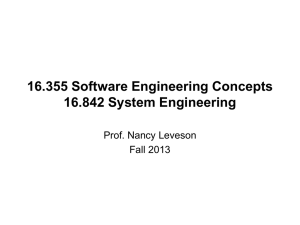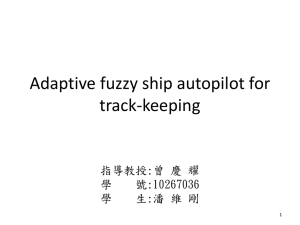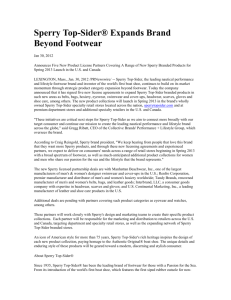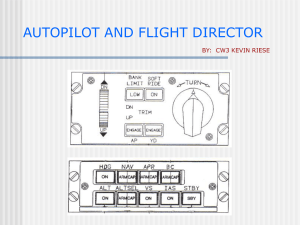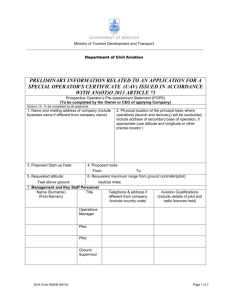EIS_Mini_Autopilot_-_Final
advertisement
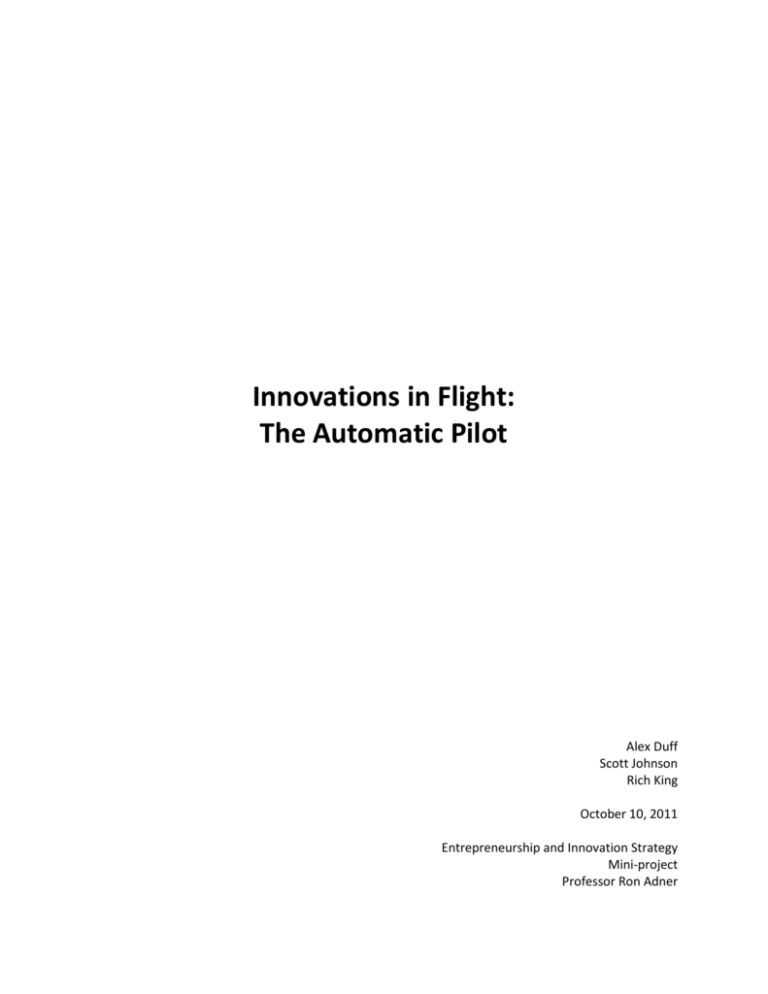
Innovations in Flight: The Automatic Pilot Alex Duff Scott Johnson Rich King October 10, 2011 Entrepreneurship and Innovation Strategy Mini-project Professor Ron Adner Introduction The automatic pilot (“autopilot”) was presented to the world on June 18, 1914 in a spectacular display by its inventor, Lawrence Sperry, at an airplane safety competition in France. Aside from being an aviation pioneer, Sperry was the son of the inventor of the gyrocompass, Elmer Sperry. The gyrocompass was already beginning to see duty on ships, helping to keep them on course despite the effects of rough waters. Sperry reasoned that gyroscopes could be fitted to planes to keep them on course without the need of continuous pilot input and attention. The invention was a major step forward for aviation and eventually became required equipment on all planes with more than 20 seats. It has been refined and improved over the years to improve air travel safety and efficiency. Value Vision With its debut at an air safety competition, it is not surprising that safety was the primary motivator for the creation of the autopilot. The autopilot has enhanced air safety in many different ways. First, it reduces pilot fatigue by allowing the pilot to focus on more important tasks other than keeping the plane level and on a straight course. Continuous attention to the controls is exhausting over long trips and results in more pilot errors. Second, pilots were able to catch potential engine or navigational issues more effectively since the autopilot handled the primary job of flying the plane. Third, the autopilot reduced human error by providing more consistent flight as well as more standardized approaches and departures. And finally, in more recent years the autopilot has been able to adjust for weather and air traffic related issues. One modern autopilot system even offers an algorithm designed to level an airplane in the event of a loss of control. A regional airline pilot reflects on the importance of the autopilot to safe flight: “The use of an autopilot to lighten the workload can literally be a lifesaver. In an emergency situation, especially, handing the basic nuts and bolts of flying over to "George" helps ensure a successful outcome when one crewmember is running an emergency checklist, and the other is simultaneously coordinating efforts of the company dispatchers, flight attendants on board, air traffic control, and pointing the airplane toward a destination for immediate landing, if needed.” Improved safety has had profound impacts on the feasibility of airline travel and military adoption of the airplane. From a commercial standpoint, the autopilot indirectly enhances passenger confidence since it contributes to impressive safety records and provides for a smoother ride. Confidence in airline safety is vital to the success of the industry. For the military, improved aircraft safety means reduced fatalities and the completion of more missions. The autopilot contributed to the aircraft becoming a vital tool for combat operations. In addition to improved safety, the autopilot greatly enhanced airplane efficiency and practicality. First, with reduced pilot fatigue, airplane manufacturers were free to design faster planes with longer ranges, thus reducing travel times and making the world more connected. Second, the ability to maintain a straight and steady course also decreased travel times as well as fuel consumption. Slight pilot corrections add up to costly wastes in fuel and time. Third, autopilots reduce training costs and time thanks to increased standardization and labor savings. And finally, more modern autopilot systems also allow planes to fly closer together, thereby increasing the capacity of jet lanes. These gains in efficiency and practicality contribute to feasibility of commercial airlines as businesses. With fuel accounting for the vast majority of airline operating costs, small gains in efficiency add up to big savings for major airlines. The autopilot is the foundation block for modern flight automation. Important developments such as drones and automatic take-offs and landings continue to improve air travel as well as combat operations. The autopilot has created unprecedented value and allowed the aviation industry to grow. Ecosystem Map and Risk Assessment The success of Lawrence Sperry’s autopilot device depended on the successful resolution of several ecosystem risks: Co-Innovation Risk One of the biggest problems that Sperry faced early on was that the aviation industry was still very young. Since aircraft at the time employed different methods of operating the plane’s controls, pilots had to learn completely different means of flying the planes. As a result, Sperry could not develop just one autopilot that would work for all of the different plane manufacturers at the time. This was resolved through the universal adoption of the Deperdussin System in 1917 (almost four years after the invention of autopilot), which standardized airplane flight controls across all manufacturers. This allowed Sperry to use essentially one design for the multitude of airplane manufacturers. Until the standardized system was adopted, it was almost impossible for Sperry to provide different autopilot designs for all of the different types of airplane control setups. Execution Risk Lawrence Sperry was fortunate in his development of the autopilot to be working within the confines of the Sperry Gyroscope Company and with immediate access to the Curtiss Aeroplane Company. The Sperry Gyroscope Company was already manufacturing gyrostabilizers and gyrocompasses for marine use at the time of the autopilot invention. Lawrence Sperry was able to utilize the company’s supply chain in the development of the autopilot. For testing purposes and to help showcase his invention, he had direct access to Curtiss Aeroplane. Additionally, Lawrence Sperry had experience building his own airplanes and used the initial prototype and subsequent prototypes exclusively in his own aircraft to help promote autopilot. Adoption Chain Risk Military Use: Both the U.S. and the French military played a strong role in the development of the autopilot. The U.S. Navy underwrote Sperry’s research and designated Lieutenant Patrick Bellinger to assist him and act as a watchdog during testing in 1913. Additionally, Bellinger participated in most if not all test flights. Although originally unconfident in the device, over time he became one of its major proponents, helping to spread the adoption of autopilot into the military. Lawrence Sperry also worked with the U.S. Army Air Service to incorporate the autopilot into unmanned aircraft to be used as early guided missiles during World War I. Although the military did not immediately adopt the autopilot for use in World War I, they continued their interest in its development. By 1922, automatic pilots were in trial for military aviation by the French, Japanese, and U.S. governments. Use of the autopilot really picked up during World War II, where it was used in conjunction with weapon sighting equipment by the Germans. With the Sperry autopilot a fixture in many of the bombers that flew over Europe, a whole generation of pilots was trained on its usage, an important fact as commercial aviation began to adopt the autopilot for long distance flight and former military pilots entered the commercial sector. Commercial Use: Although autopilot had been around since 1913, its appeal did not really take off until longer-stage flying became more prominent, which occurred during the 1930’s. Early pilots were cautious with the use of autopilot, fearing that it would not function as well as a human pilot. As planes became heavier and cross-country flying became more prominent, the autopilot gained favor. By 1938, autopilot (and more specifically, the Sperry autopilot) had been fitted as standard equipment on most of the world’s leading airlines, including British Airways and Imperial Airways. A large percentage of the adoption came through the adaptation of military aircraft into civil airlines following World War II, retaining the existing the autopilots, of which the majority were manufactured by Sperry. Strategy Assessment Regardless of which markets Sperry had chosen to pursue with the autopilot system, he and his team began with a chicken-and-egg problem. On the one hand, no regulator, airline, manufacturer, pilot, or passenger would gain comfort with his autopilot system without extensive pre-testing to ensure a high level of safety. On the other hand, the only way to test the innovation was to get planes in the air running on autopilot. He dealt with this in two important ways. First, Sperry and his team sold the idea to the US Navy, securing funding for their research as well as first adopter of the technology. The Navy’s need for long-distance flight and greater risk tolerance compared to the commercial sector made the organization a natural fit. Another key consideration here was that, while skeptical pilots held a great deal of adoption sway in the commercial aviation sector, they had substantially less influence in the military’s hierarchical structure. Additionally, Sperry and his team participated in testing the product themselves. This obviously entailed a level of risk, but they believed in their system and were thereby able to mitigate the potential for human error early on in testing by pilots who may not have understand the technology as thoroughly. In order to win over the pilot contingency, Sperry wisely did not push the product as a replacement for their services, but rather as a tool to make their job safer and easier. Because of this, he did not receive as much pushback from pilots on the innovation as he otherwise would have. Also importantly, the system was designed to leave engagement of the autopilot up to the pilot’s discretion, with the ability to override the system as a safety precaution. As such, even those pilots who preferred to fly manually had nothing to lose from the innovation’s adoption by manufacturers and airlines. Airlines, at this point having the benefit of successful military testing, faced a primarily economic decision. Had the autopilot needed to be specified in at the OEM, it would have taken much longer to phase the system into the commercial fleet since the cost of new aircraft was so substantial. Instead, it was initially designed to be installed after-market (though this quickly changed as the device matured). The standardization of flight controls allowed Sperry to create the device as one-size-fits-all. This it allowed manufacturers to adopt the innovation with less additional capital expenditure. Sperry also made deft use of positive public relations to win over passengers, entering into the 1914 Concours de la Securité en Aéroplane, a high-profile air safety competition put on by the French government. He won first prize for his demonstration of the autopilot, in which he and his copilot simultaneously climbed out onto the wings of the aircraft, leaving the controls unattended to the amazement of the crowd. Another PR victory came in July of 1933, when pilot Wiley Post credited his success in flying around the world to his Sperry autopilot, nicknamed “Mechanical Mike.” These sorts of milestones were captured by the popular press and dazzled readers and viewers back home with headlines like Popular Science’s “Robot Air Pilot Keeps Plane on True Course.” The first time autopilot was used in commercial aviation was December of 1931, seventeen years after the first public exposition of the technology. The Department of Commerce granted approval for its use on Eastern Air Transport flights aboard the eighteen-passenger Curtiss Condor, the only limitation being that pilots were not to engage the system during take-offs and landings. Again, the first flight was thoroughly documented by video to aid in winning over remaining skeptics. In the end, the innovation strategy employed by Sperry won over key adopters such as manufacturers, airlines, pilots, and passengers, thereby allowing his now-ubiquitous invention to see the light of day. Once this had happened, it won on its merits by delivering what it promised: a safer, easier, and more consistent air travel experience. Sources: The Automobile, Volume 36, Issue 18. 1917. “Autopilot to Flight-Control System.” Flight, April 1957. Bennett, Stuart. A History of Control Engineering, 1930-1955. Peter Peregrinus, London, 1993. “The New Aveline Automatic Pilot.” Flight, August 1922. “Robot Air Pilot Keeps Plane on True Course." Popular Mechanics, December 1930. Scheck, William. “Lawrence Sperry: Autopilot Inventor and Aviation Innovator.” Aviation History, November 2004. “Sperry Automatic Gyro Pilot.” Advertisement: Flight, October 1938.
